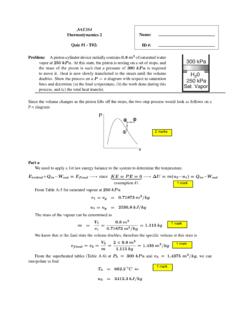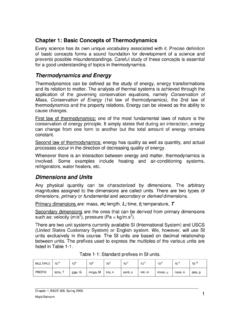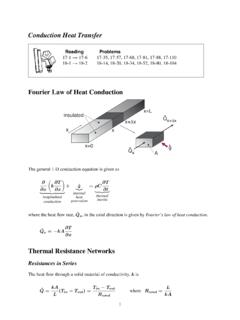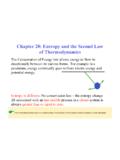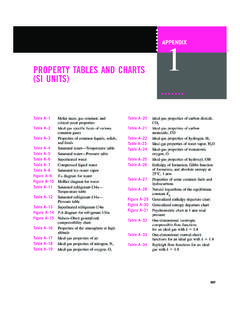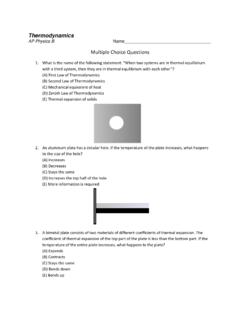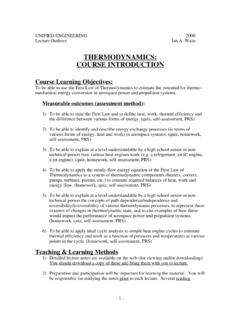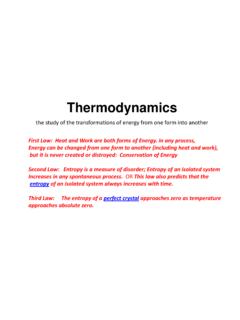Transcription of Basic Concepts of Thermodynamics - University of Waterloo
1 Basic Concepts of ThermodynamicsReadingProblems2-1 2-102-44, 2-59, 2-78, 2-98 Thermal SciencesThermodynamicsHeat TransferFluids MechanicsThermalSystemsEngineeringThermo dynamicsFluid MechanicsHeat TransferConservation of massConservation of energySecond law of thermodynamicsPropertiesFluid staticsConservation of momentumMechanical energy equationModelingConductionConvectionRadi ationConjugateThermodynamics:the study of energy, energy transformations and its relation to matter. The anal-ysis of thermal systems is achieved through the application of the governing conservationequations, namelyConservation of Mass,Conservation of Energy(1st law of thermodynam -ics), the 2nd law of Thermodynamics and the property Transfer:the study of energy in transit including the relationship between energy, matter,space and time. The three principal modes of heat transfer examined are conduction, con-vection and radiation, where all three modes are affected by the thermophysical properties,geometrical constraints and the temperatures associated with the heat sources and sinks usedto drive heat Mechanics:the study offluids at rest or in motion.
2 While this course will not deal exten-sively withfluid mechanics we will be influenced by the governing equations forfluidflow,namelyConservation of MomentumandConservation of :tracking the movement of matter and energy on a particle by particle basisMacroscopic:use the conservation equations (energy and mass) to track movement of matter andenergy on an average over afixed domain (referred to as classical Thermodynamics )Energy the total energy of the system per unit mass is denoted aseand is given ase=Em kJkg if we neglect the contributions of magnetic, electric, nuclear energy, we can write the totalenergy asE=U+KE+PE=U+mV22+mgzDimensions and UnitsSI: International System SI is the preferred because it is logical (base 10) and needs no correction factors unit convention:ParameterUnitsSymbollength,Lm etersmmass,mkilogramskgtime,tsecondsstem perature,TkelvinKvelocity,Vmeter per second, L/tm/sacceleration,ameter per second squared L/t2m/s2force,Fnewton, m L/t2 Nenergy,Ejoule m L2/t2J2 Thermodynamic SystemsIsolated BoundarySystemSurroundingsWorkHeatSystem Boundary(real or imaginaryfixed or deformable)System- may be as simpleas a melting ice cube- or as complex as anuclear power plantSurroundings- everything that interactswith the systemSYSTEM:Closed System:composed of a control (orfixed) mass where heat and work can cross theboundary but no mass crosses the System:composed of a control volume (or region in space) where heat, work, andmass can cross the boundary or the control surfaceweightspistongassystemboundarygfa nengine coreClosed SystemOpen Systemby-pass flowWORK & HEAT TRANSFER.
3 Work and heat transfer are NOTproperties they are the forms that energy takes tocross the system boundary3 Thermodynamic Properties of SystemsBasic DefinitionsThermodynamic Property:Any observable or measurable characteristic of a system. Any math-ematical combination of the measurable characteristics of a systemIntensive Properties:Properties which are independent of the size (or mass) of the system they arenotadditive XA+B =XA+XB examples include: pressure, temperature, and densityExtensive Properties:Properties which are dependent of the size (or mass) of the system they are additive XA+B=XA+XB examples include: volume, energy, entropy and surface areaSpecific Properties:Extensive properties expressed per unit mass to make them intensive prop-erties specific property (intensive) extensive propertymassMeasurable Properties P, V, T,andmare important because they are measurable quantities. Many other thermo-dynamic quantities can only be calculated and used in calculations when they are related toP, V, T,andm Pressure(P)and Temperature(T)are easily measured intensive : They are not always independent of one another.
4 Volume(V)and mass(m)are easily measured extensive propertiesPressure P ressure=ForceArea; Nm2 Pa influids, this is pressure (normal component of force per unit area) in solids, this is stress4absolutepressuregaugepressurevacu umpressureabsolutevacuum pressureABSOLUTEATMOSPHERICPRESSUREP ressurePatmTemperature temperature is a pointer for the direction of energy transfer as heatQQTATATATATBTBTBTB> <0thLaw of Thermodynamics :if system C is in thermal equilibrium with system A,and also with system B, thenTA=TB=TCState and EquilibriumState Postulate how long does the list of intensive properties have to be in order to describe the intensivestate of the system?5samesubstanceABm = 10 kgAm = kgBT = 500 KP = MPav = m /kgu = System A and B have the same intensive state, but totally different extensive Postulate (for a simple compressible system):The state of a simplecompressible system is completely specified by 2 independent and intensive properties.
5 Note: a simple compressible system experiences negligible electrical, magnetic, gravita-tional, motion, and surface tension effects, and onlyPdVwork is done in a single phase system,T,v,andPare independent and intensive (in a multiphase systemhowever,TandPare not independent) if the system is not simple, for each additional effect, one extra property has to be known tofix the state. ( if gravitational effects are important, the elevation must be specified andtwo independent and intensive properties) it is important to be able to: find two appropriate properties tofix the state find other properties when the state isfixed (we will discuss this later)Thermodynamic Processes theprocessis any change from one equilibrium state to another. (If the end state = initialstate, then the process is a cycle)6 theprocess pathis a series intermediate states through which a system passes during theprocess (we very seldom care what the process path is) processesare categorized based on how the properties behave: isobaric (P=constant) isothermal (T=constant) isochoric or isometric (V=constant) isentropic (s=constant) isenthalpic (h=constant) adiabatic (no heat transfer)Stored Energy how is energy stored in matter?
6 Stored Energy=E=KE+PE+U Kinetic Energy: Energy due to motion of the matter with respect to an external referenceframe (KE=mV2/2) Potential Energy: Energy due to the position of the matter in a forcefield (gravitational,magnetic, electric). It also includes energy stored due to elastic forces and surface tension(PE=mgz) Internal Energy = microscopic forms of energy,U) forms of the energy in the matter due to its internal structure (independent of externalreference frames)Transit EnergyHeat transit form of energy that occurs when there is T(a temperature gradient) notation -Q(kJ),q(kJ/kg), Q(kW), q(kW/kg)Wo r k transit form of energy that occur due to all other driving forces notation -W(kJ),w(kJ/kg), W(kW), w(kW/kg)7 Properties of Pure SubstancesReadingProblems3-1 3-73-49, 3-52, 3-57, 3-70, 3-75, 3-106,3-9 3-113-121, 3-123 Pure Substances aPure Substanceis the most common material model used in Thermodynamics . it has afixed chemical composition throughout (chemically uniform) a homogeneous mixture of various chemical elements or compounds can also be con-sidered as a pure substance (uniform chemical composition) a pure substance is not necessarily physically uniform (different phases)Phases of Pure Substances a pure substance may exist in different phases, where a phase is considered to be a physicallyuniform 3 principal phases:Solids: strong molecular bonds molecules form afixed (but vibrating) structure (lattice)Liquids: molecules are no longer in afixed position relative to one another moleculesfloat about each otherGases: there is no molecular order intermolecular forces 0 Behavior of Pure Substances (Phase Change Processes) Critical Point:liquid and vapor phases are not distinguishable Triple point.
7 Liquid, solid, and vapor phases can exist together1sublimationvaporizationmeltingm eltingtriple pointcritical pointSOLIDVAPORLIQUID vaporizationcondensationsublimationsubli mationfreezingmeltingPTsubstances thatexpand on freezingsubstances thatcontract on freezingP0P0P0P0P0P0dQdQdQdQdQSSLLLGGS+G L+GSS+LGLT vcritical pointstauratedvaporlinetriple point linesaturatedliquidlinefusionline2T vDiagram for a Simple Compressible Substance consider an experiment in which a substance starts as a solidand is heated up at constantpressure until it all becomes as gas depending on the prevailing pressure, the matter will pass through various phase transforma-tions. AtP0:1. solid2. mixed phase of liquid and solid3. sub-cooled or compressed liquid4. wet vapor (saturated liquid-vapor mixture)5. superheated vaporThe Vapor Dome general shape of aP vdiagram for a pure substance is similar to that of aT vdiagramvcritical pointvfgsubcooledliquidsaturatedliquid lineL+GvfvgPP (T)satsaturatedvapor linegas (vapor)two-phase region(saturated liquid &saturated vapor)TcrTT express values of properties for conditions on the vapor dome as:specificvolume:vf,vgandvfg=vg vfinternal energy:uf,ugandufg=ug ufspecific enthalpy:hf,hgandhfg=hg hfspecific entropy:sf,sgandsfg=sg sf3 in the two phase region, pressure and temperature cannot be specified independentlyPsat=P(Tsat) Tsat=T(Psat)this only holds true under the vapor dome in the two-phase Two-Phase RegionQuality x=mgm=mgmg+mfLGx=m /mg1-x = m /mftotal mass of mixture m=mg+mfmass fraction of the gas x=mg/mmass fraction of the liquid 1 x=mf/mProperties of Saturated Mixtures all the calculations done in the vapor dome can be performed using Tables.
8 In Table A-4, the properties are listed under Temperature in Table A-5, the properties are listed under Pressure use if given mixture:1) is saturated, 2) has a quality, 3) liquid & vapor are presentv=Vm=Vf+Vgm=mfvf+mgvgm=(1 x)vf+xvg=vf+x(vg vf)=vf+xvfgx=v vfvfg4 Properties of Superheated Vapor superheated vapor is a single phase (vapor phase only). TandPare independent of each other in the single-phase region properties are typically calculated as a function ofTandPvLL+GGTT (P)satPPP = 100 kPastate: 200 C and 100 kPaoT = 200 CoProperties of Sub-cooled LiquidvLL+GGTT (P)satPPP = 100 kPastate: 20 C and 100 kPaoT=20 Co5 can be treated as incompressible (independent ofP)v=v(T,P) v v(T)=vf(T)u=u(T,P) u u(T)=uf(T)s=s(T,P) s s(T)=sf(T) while property values for the sub-cooled liquids are not available as a function of temperatureand pressure, they are available as a function of temperature only. for enthalpy:h(T,P)=u(T,P)+v(T,P)P uf(T)+vf(T)P=uf(T)+vf(T)Psat(T) hf(T)+vf(T)[P Psat(T)]=hf(T)+vf(T)[P Psat(T)]Equation of State for Gaseous Pure SubstancesThermodynamic relations are generally given in three different forms:Tables:water (Tables A-4 A-8), R134a (Tables A-11 A-13)Graphs:water (Figures A-9 & A-10), R134a (Figure A-14)Equations:air (Tables A-2 & 3-4) since most gases are highly superheated at atmospheric conditions.
9 This means we have touse thesuperheat tables but this can be veryinconvenient a better alternative for gases:use the Equation of Statewhich is a functional relationshipbetweenP, v,andT(3 measurable properties)Ideal Gases gases that adhere to a pressure, temperature, volume relationshipPv=RTorPV=mRTreferred to as ideal gases6 whereRis the gas constant for the specified gas of interest (R=Ru/ M)Ru=Universal gas constant, (kmol K) M=molecular wieght (or molar mass) of the gas (see Table A-1)) When is the ideal gas assumption viable? for a low density gas where: the gas particles take up negligible volume the intermolecular potential energy between particles is small particles act independent of one another Under what conditions can it be used? low density high temperatures - considerably in excess of the saturation region at very low pressuresReal Gases experience shows thatreal gasesobey the following equation closely:Pv=ZRT(TandPare in absolute terms) this equation is used tofind the third quantity when two others are known Zis the compressibility factor Note:Rair= K, RH2= K what is the compressibility factor (Z)?
10 Zcharts are available for different gases, but there are generalizedZcharts that canbe used for all gases if we reduce the properties with respect to the values at the critical point, pressure=Pr=PPcPc=critical pressurereduced temperature=Tr=TTcTc=critical temperature7 Reference Values foru, h, s values of enthalpy,hand entropy,slisted in the tables are with respect to a datum where wearbitrarily assign the zero value. For instance:Tables A-4, A-5, A-6 & A-7:saturated and superheated water - the reference for bothhfandsfis taken as0 C. This is shown as follows:uf(@T=0 C)=0kJ/kghf(@T=0 C)=0kJ/kgsf(@T=0 C)=0kJ/kg KTables A-11, A-12 & A-13:saturated and superheated R134a - the reference for bothhfandsfis taken as 40 C. This is shown as follows:hf(@T= 40 C)=0kJ/kghf(@T= 40 C)=0kJ/kgsf(@T= 40 C)=0kJ/kg KOthers:sometimes tables will use0 Kas the reference for all tables. While this standard-izes the reference, it tends to lead to larger values of enthalpy and of the Stored Energy for most of our 1st law analyses, we need to calculate E E= U+ KE+ PE for stationary systems, KE= PE=0 in general: KE=12m(V22 V21)and PE=mg(z2 z1) how do we calculate U?
